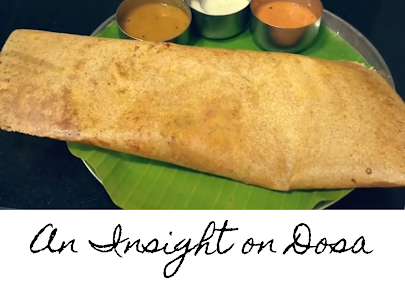Dosa is one of the favorite breakfast options for vegetarians. It originated in Southern India, but now it's quite popular in the whole nation. It comes in many verities and tastes like plain dosa, masala dosa, rava dosa, benne dosa and many more. Believe me, if I just write a page about each dosa a whole book could be written on the same. With taste, dosa is also very nutritious and is considered as a complete diet. For vegetarians, it is one of the best sources of protein, low in calories, a good source of carbohydrates, as it made from the fermented batter of rice and Urad daal (black gram lentil) which makes it easy to digest and helps in losing weight.
Preparation and serving:
For its preparation both black gram lentil and rice are soaked in water in a ratio of 1:4 overnight, then ground separately in a grinder, after that both batters are mixed and left for approximately 6 hours for fermentation, then the batter is ready for preparing dosas. The batter is spread over the flat cast iron tava (thick iron sheet rectangular or circular in shape) for making round flat sheets, these sheets are cooked from only one side and filling is spread on the middle of the round flat batter sheet then with the help of a spatula it is rolled like a spring roll, and now our dosa is ready to be enjoyed with Sambar, coconut and tomato, and peanut chutneys.
Brief History:
There have been two
major findings of the origin of dosa, one says it originated in Karnataka and another talks about its
origin in Tamilnadu. Let’s discuss Karnataka’s case first. Its first mention has been found in a Sanskrit text written in 1125 AD (Some
scholars also say it was written in 1129 AD) by King Someshvara III also known
by the name Kalyani Chalukya (the son and successor of Vikramaditya VI) who ruled the Southern Indian State named Karnataka,
and according to Mr. Parameswaran Thankappan Nair or Mr. P. Thankappan Nair (born 30th April
1933 an independent researcher, historian and Malayali author) also mentioned that Dosa first originated Karnataka in a town named Udipi.
But according to Mr. K. T. Achaya (born Oct 6th, 1923 and who was a chemist, food scientist, nutritionist and food historian) that dosa was first originated in Tamilnadu because its mention can be found in ancient Tamil literature 'Sangam Literature' written around 1000 AD.
The original form of dosa belonging
to Karanataka is thinner and crispier whereas the Tamil original form was thicker
and softer. Uttapam is also one of the forms of dosa which is thicker and softer
than the present dosa we know today. Maybe a possibility that Uttapam or something similar to it was originated in Tamil around 1000 AD and the dosa we know today was
originated in Karnataka, this is what I could think
of as one of the possibilities.
Now:
As a child I have lived mostly in north India and finding south Indian food was very tough, only Indian coffee houses used to serve south Indian food at that time. But with the passage of time, south Indian food availability became very easy. As I mentioned in my blog on ‘Idli’ that nowadays south Indian food could be found as street food and almost all popular restaurants serve all south Indian dishes.
It
doesn’t matter where you live in India, there are few dishes and snacks which have become an integral part of the culture and identity, the same goes for dosa
too. At present dosa has been prepared and enjoyed in almost all Indian kitchens
and houses.





Comments
Post a Comment